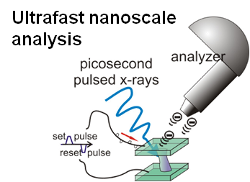In topical area B, we target the understanding of the microscopic mechanism underlying the highly nonlinear switching kinetics and how it can be influenced by the material’s composition and by cell design. Fast switching is of particular interest for reducing the energy consumption. In a resistive memory, the dissipated energy scales with the applied pulse length and the maximum required current. To understand what determines the switching speed and its limits is thus a key factor for developing energy-efficient resistive memory cells. Obviously, this is closely linked with the scalability of VC and PC cells and with their reliability.
In several of the projects during the second period of the SFB, new techniques and methods have been developed which will be employed and/or extended in the third period. For example, an integrated nanoheater has been developed. The heater structures in close proximity to the resistively switching material will be used for both VCM and PCM cells. This design enables temperature-dependent investigations with respect to dynamics, e.g. fast pulse-driven recrystallization, and retention.
We will focus on operando microspectroscopy by directly following the variation of the local chemical and electronic states during switching of oxides. As the ultimate goal, we want to map the details of a switching process in real time, which requires a time-resolution in the nano or picosecond regime. An appropriate electrical pump – photon probe technique has been established at national synchrotron beamlines.
An advanced in situ TEM specimen holder design has been developed and it will be used to apply electrical contacts and precise temperature control to specimens that will be studied on dedicated chips fabricated using micro-electromechanical systems (MEMS) technologies. Direct observations of switching processes in both PC and VC materials at the sub-nm scale will be targeted including studies of the factors that limit switching reliability and scalability.
It has been shown that the Peierls distortion plays an important role in amorphous and crystalline PCM. This distortion in a number of chalcogenides is closely related to the metavalent bonding and will be studied in conjunction with the recrystallization kinetics.
The experimental studies will be complemented by multiscale modeling, ranging from ab initio approaches, via kinetic Monte Carlo simulations, molecular dynamic studies, to drift / diffusion / reaction finite element simulations and compact modeling. In particular, the electrode/chalcogenide interfaces will be addressed by the modeling work.

